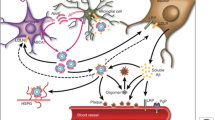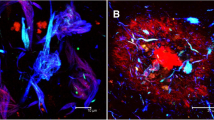Summary.
Recent epidemiological and clinico-pathologic data suggest overlaps between Alzheimer disease (AD) and cerebrovascular lesions that may magnify the effect of mild AD pathology and promote progression of cognitive decline or even may precede neuronal damage and dementia.Vascular pathology in the aging brain and in AD includes: 1. cerebral amyloid angiopathy (CAA) with an incidence of 82–98% often associated with ApoEε2 and causing a) cerebral mass hemorrhages (around 70%, mainly in the frontal and parieal lobes), b) multiple or recurrent microhemorrhages (15%), and c) ischemic (micro-)infarcts or lacunes (around 20%). The frequency of these lesions increases with the severity of CAA and shows no correlation with that of senile amyloid plaques. CAA, significantly more frequent in patients with cerebral hemorrhages or infarcts than in aged controls, is an important risk factor for cerebrovascular lesions in AD. 2. Microvascular changes with decreased density and structural abnormalities causing regional metabolic and blood-brain barrier dysfunctions with ensuing neuronal damage. In large autopsy series of demented aged subjects, around 80% show Alzheimer type pathology, 20–40% with additional, often minor vascular lesions, 7–10% “pure” vascular dementia, and 3–5% “mixed” dementia (combination of AD and vascular encephalopathy). AD cases with additional minor cerebrovascular lesions have significantly more frequent histories of hypertension or infarcts than “pure” AD patients.
Vascular lesions in AD include cortical microinfarcts, subcortial lacunes, white matter lesions / leukoencephalopathy, small hemorrhages and corticosubcortical infarcts, while in mixed type dementia multiple larger or hemispheral infarcts are more frequent. Small infarcts in AD patients have no essential impact on global cognitive decline which mainly depends on the severity of Alzheimer pathology, but in early stage of AD they may influence and promote the development of dementia. Recent studies showed lower density of plaques and tangles in brains with cerebrovascular lesions, and similar severity of dementia was related to fewer AD lesions in brains with than in those without small vascular lesions. Further studies will help to elucidate the risk factors and impact of cerebrovascular lesions on the development and progression of dementia in AD.
Similar content being viewed by others
Author information
Authors and Affiliations
Additional information
Received November 2, 2001; accepted January 16, 2002
Rights and permissions
About this article
Cite this article
Jellinger, K. Alzheimer disease and cerebrovascular pathology: an update. J Neural Transm 109, 813–836 (2002). https://doi.org/10.1007/s007020200068
Issue Date:
DOI: https://doi.org/10.1007/s007020200068




